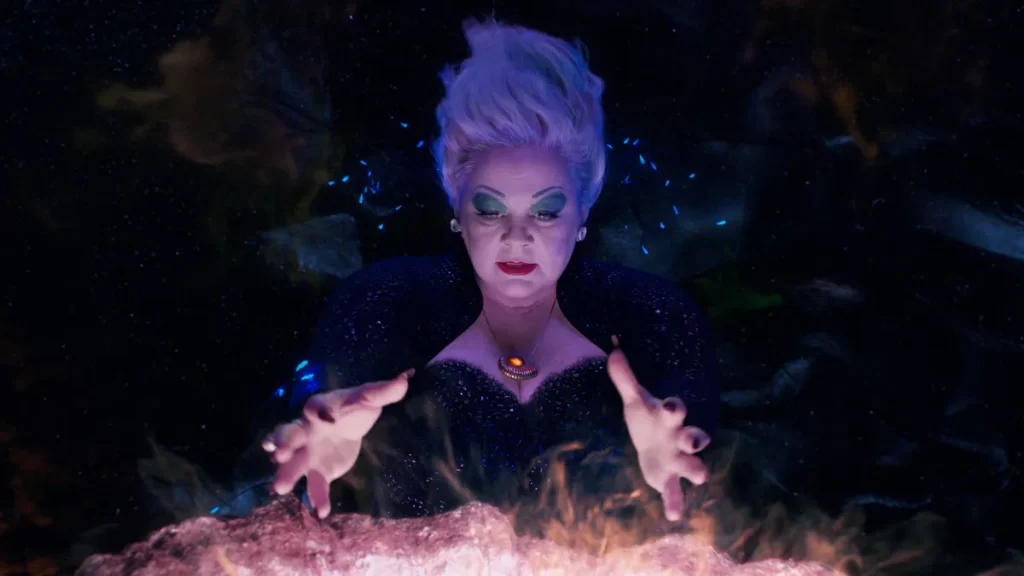The Pitch: Picture this: in a distant underwater realm, a young mermaid becomes infatuated, perhaps unwisely, with a human man. Believing that her best shot at winning his heart is to become human herself, she enters into a dubious agreement with a nefarious sea sorceress (who’s somehow also her relative now?). Good thinking, Ariel. Absolutely flawless. But that’s “The Little Mermaid” for you. It’s a modern twist on Hans Christian Anderson’s timeless tale, which was brought to animated life in 1989 by John Musker and Ron Clements. Now, director Rob Marshall has reimagined it in all its live-action splendor.
Down Where It’s Wetter: The term “extravaganza” aptly describes how this latest Disney live-action rendition expands on the original. It’s not just about adding narrative substance, but more of… well, everything. Marshall and screenwriter David Magee utilize those added 52 minutes to incorporate a few more tunes (penned by the original maestro, Alan Menkin, with Lin-Manuel Miranda crafting the lyrics), and also to provide richer context to the 1830s Caribbean and the majestic underwater kingdom.
With Halle Bailey portraying the passionate mermaid, Jonah Hauer-King as her charming prince, and Melissa McCarthy mastering the role of the conniving sea enchantress well-versed in legal jargon, the movie has its moments. I witnessed firsthand the audience’s applause during its rendition of “Under the Sea” at a press screening. However, the film struggles to truly establish its unique purpose, aside from showcasing impressive casting and, undoubtedly, bolstering Disney’s coffers.
A Hot Crustacean Band: As with most live-action adaptations nowadays, CGI plays a pivotal role in character creation. Ranking the digital ensemble from the most captivating to the least, we have:
- Sebastian (Daveed Diggs): Though his facial features are far from human, those exaggerated animated eyes steal the show… once you get over their initial mesmerizing effect.
- Scuttle (Awkwafina): Essentially a chatty bird, which seems more plausible than…
- Flounder (Jacob Tremblay): It’s not just the lifeless look in his eyes, but how the mere notion of a speaking fish seems so unsettling. Among the entire cast, his design might’ve benefited from a touch more whimsy.

Regarding the live-action performers, Bailey exudes irresistible charm, particularly in sequences where Ariel can’t communicate verbally but still aims to bond with Eric. As for Hauer-King, his features oddly conjure up images of each Jonas brother. Yet, he establishes a palpable rapport with Bailey when the narrative finally brings them together.
Javier Bardem, a consistently engaging actor, seems rather forgettable as Triton. However, the real scene-stealer is McCarthy. Her over-the-top hair and makeup lie in stark contrast to her fresh delivery, eliciting genuine laughter from the audience even in simple reaction shots. The regular close-ups aid in creating an illusion of her being untouched by the combined practical and CGI effects in her transformation scenes.
Yet, the underwater sequences do pose a challenge. The characters seem somewhat limited, either by physical restraints or their digital personas. It’s genuinely refreshing to see Ariel and Eric’s interactions in the movie’s second act. By that time, the audience yearns for genuine human interactions.
Dive Deeper Into the Story: Certain plot adjustments and additions leave the viewers scratching their heads. The heightened emphasis on Prince Eric as Queen Selina’s (Noma Dumezweni) adopted son led some to speculate a twist hinting at his merperson origins. Spoiler: That’s a dead end. It seems more like a nod to Eric’s transracial adoption. Underwater, King Triton’s daughters don’t just symbolize the seven seas — they also embody diverse ethnicities. But no explanation is provided for the sea kingdom’s multiracial royal lineage. While the story of The Little Mermaid doesn’t demand an exhaustive family tree, shedding light on the biological connection between King Triton and Ursula would certainly be intriguing.

In a tale as renowned as this, the alterations seem closest to potential spoilers. But they are worth highlighting, given some appear superfluous. For instance, Ursula introduces an amendment to the transformative spell cast on Ariel: Along with her human transformation, Ariel forgets the need to seal their agreement with a kiss from Eric. While this tweak doesn’t shift the narrative’s core, it might prevent Ariel from impulsively kissing Eric. It seems more like a nod to the more critical viewers, inadvertently spotlighting the narrative hiccup it’s meant to address.
A Symphony Under the Sea: The refreshed soundtrack introduces three additional songs. Ariel and Eric each get a new song that delves into their characters, and then there’s “The Scuttlebutt”, an expected outcome when you bring two Hamilton stars onboard.
Is “The Scuttlebutt” a musical masterpiece? Not particularly. But will youngsters revel in learning its rap segments to sing along with Awkwafina and Diggs? Without a doubt. However, the decision to omit “Les Poissons”, one of the original’s standout tracks, is questionable. Though, as some pointed out, the rendition of a song about preparing and frying photorealistic marine creatures would likely be unsettling in this live-action context.
Final Thoughts: The rationale behind this rendition of The Little Mermaid might be puzzling to some. While the film’s inclusive cast is commendable, with Bailey truly shining in her role, the alterations to the classic tale come across as merely surface-level enhancements, bestowing only a semblance of depth. And while there are sequences that dazzle the eyes, the movie’s frequent shifts towards realism or discussions about topics like trade relationships feel out of place. This narrative revolves around enchanting mermaids, magical realms, and chatty sea creatures. It doesn’t require geopolitical nuances, unforeseen familial ties, or, frankly, an additional 52 minutes of runtime.
Coming Soon: Catch The Little Mermaid in theaters starting Friday, May 26th.
